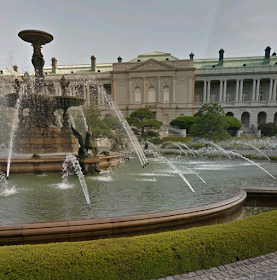The overthrow of the Shah of Iran, in 1979, was an important time for Japan because it made it's royal family, known as the Yamato Dynasty, the longest-reigning monarchy on earth. The Emperor used to share power with the Shogun, of the Samurai warrior class. Kyoto was the capital of Japan for about a thousand years, but the Tokugawa Shogunate chose to rule from Tokyo, which was then called Edo. Even though the emperor still resided in Kyoto.
Upon the Meiji Restoration, in the Nineteenth Century, when the position of the emperor was restored to full power, and the shogunate and the Samurai class was abolished, the emperor then also ruled from Tokyo, rather than Kyoto.
The emperor's Imperial Palace was built on the grounds of the old Edo Castle, from where the shogunate had ruled. Some elements of Edo Castle are still there. Following destruction of much of the palace during warfare, a new palace complex was built in the 1960s, while the eastern part of the grounds was named the East Garden.The following scenes are of the grounds of the Imperial Palace, surrounded by it's moat and the tall buildings of the city. The first image of the Imperial Palace is from Google Street View.
There are multiple scenes following. To see the scenes, after the first one, you must first click the up arrow, ^, before you can move on to the next scene by clicking the right or forward arrow, >. After clicking the up arrow you can then hide the previews of successive scenes, if you wish.
https://www.google.com/maps/@35.685175,139.7527995,3a,75y,180h,90t/data=!3m8!1e1!3m6!1s-okmHrpsJnl0%2FVqdrOVkYb5I%2FAAAAAAAAC3M%2FKkGBa5J6Qx80WuABcPnBakCNzd18rXj8Q!2e4!3e11!6s%2F%2Flh3.googleusercontent.com%2F-okmHrpsJnl0%2FVqdrOVkYb5I%2FAAAAAAAAC3M%2FKkGBa5J6Qx80WuABcPnBakCNzd18rXj8Q%2Fw203-h101-n-k-no%2F!7i8704!8i4352
We can see that Tokyo only became a major city during the Seventeenth and Eighteenth Centuries, after the Tokugawa Shogunate was based in what had been the village of Edo, and in the Nineteenth Century, after the Meiji Restoration, by it's shrines. The first two of the following images from Google Street View are of the Meiji Shrine, and the third is of the Yasukuni Military Shrine. While built in traditional Japanese style, the shrines do not look extremely old.
Akasaka Palace was built in 1909. It is used as a guest palace, but Emperor Hirohito once lived there for several years. Contrary to some travel guides, Akasaka Palace is not an exact copy of Buckingham Palace, although the resemblance between the two is striking. Akasaka Palace is not on the grounds of the Imperial Palace, but is not far away. Here are some scenes of the front and back of the palace, from Google Earth and Street View.
This is the buildings of central Tokyo. Six images from Google Earth and Street View.
These three images, of the famous Ginza District, are from Google Street View.
Here are some scenes around Shinjuku, starting in Shinjuku Station:
https://www.google.com/maps/@35.6904283,139.7004694,3a,75y,346.42h,90t/data=!3m8!1e1!3m6!1s-t8-mWmpCTTo%2FVEZKpDv5YJI%2FAAAAAAAALYc%2FSVAFHzCXBIcpu5pz8noC8vo0sZAP2TskACLIB!2e4!3e11!6s%2F%2Flh4.googleusercontent.com%2F-t8-mWmpCTTo%2FVEZKpDv5YJI%2FAAAAAAAALYc%2FSVAFHzCXBIcpu5pz8noC8vo0sZAP2TskACLIB%2Fw203-h101-n-k-no%2F!7i3584!8i1792
There is a gap between the time that passenger trains came into widespread use, and the time when modern architecture appeared. Train stations built during this time are of stone architecture. Tokyo Station is Tokyo's equivalent of Grand Central Station in New York, or St. Pancras Station in London, or Chhatrapati Shivaji Terminus in Mumbai, or Union Station in Toronto. Here are some views around Tokyo Station, starting in a mall next to the station.
https://www.google.com/maps/@35.6796074,139.7682316,3a,75y,90t/data=!3m8!1e1!3m6!1sOx_TefEEPgRNAPZQ5BRglA!2e0!3e2!6s%2F%2Fgeo3.ggpht.com%2Fcbk%3Fpanoid%3DOx_TefEEPgRNAPZQ5BRglA%26output%3Dthumbnail%26cb_client%3Dmaps_sv.tactile.gps%26thumb%3D2%26w%3D203%26h%3D100%26yaw%3D311.06223%26pitch%3D0!7i13312!8i6656
Another major train station, built in traditional style, is Shinagawa Station. Here are some scenes starting there. Some of the scenes are in a nearby aquarium. Emperor Hirohito was an expert in marine biology.
https://www.google.com/maps/@35.628343,139.7382596,3a,75y,85.54h,89.95t,0.29r/data=!3m7!1e1!3m5!1sWMBlDkfbjfpDFYeZWw1kEg!2e0!6s%2F%2Fgeo2.ggpht.com%2Fcbk%3Fpanoid%3DWMBlDkfbjfpDFYeZWw1kEg%26output%3Dthumbnail%26cb_client%3Dmaps_sv.tactile.gps%26thumb%3D2%26w%3D203%26h%3D100%26yaw%3D164.9095%26pitch%3D0!7i13312!8i6656
Finally here is the major stadium, known as Tokyo Dome. There is an amusement park and a Japanese-style garden nearby.
This is the buildings of central Tokyo. Six images from Google Earth and Street View.
Tokyo has it's version of the Eiffel Tower, Tokyo Tower. Two images from Google Street View.
Then there is the Sky Tree. Four images from Google Earth and Street View.
But Mount Fuji is the real symbol of Tokyo and of Japan. Image from Google Street View.
One way to see a large city is by way of it's major train stations. The busiest train station in the world is Shinjuku Station. In a visit to Paris, we saw that the Gare du Nord was the busiest train station outside of Japan, but Shinjuku handles even more passengers than that. Shinjuku is built on an area that is believed to be geologically stable, and that is where many of Tokyo's skyscrapers are located. Tokyo had a devastating earthquake in 1923.
This is the tall buildings of Shinjuku. Two images from Google Earth.
This is the tall buildings of Shinjuku. Two images from Google Earth.
Here are some scenes around Shinjuku, starting in Shinjuku Station:
https://www.google.com/maps/@35.6904283,139.7004694,3a,75y,346.42h,90t/data=!3m8!1e1!3m6!1s-t8-mWmpCTTo%2FVEZKpDv5YJI%2FAAAAAAAALYc%2FSVAFHzCXBIcpu5pz8noC8vo0sZAP2TskACLIB!2e4!3e11!6s%2F%2Flh4.googleusercontent.com%2F-t8-mWmpCTTo%2FVEZKpDv5YJI%2FAAAAAAAALYc%2FSVAFHzCXBIcpu5pz8noC8vo0sZAP2TskACLIB%2Fw203-h101-n-k-no%2F!7i3584!8i1792
There is a gap between the time that passenger trains came into widespread use, and the time when modern architecture appeared. Train stations built during this time are of stone architecture. Tokyo Station is Tokyo's equivalent of Grand Central Station in New York, or St. Pancras Station in London, or Chhatrapati Shivaji Terminus in Mumbai, or Union Station in Toronto. Here are some views around Tokyo Station, starting in a mall next to the station.
https://www.google.com/maps/@35.6796074,139.7682316,3a,75y,90t/data=!3m8!1e1!3m6!1sOx_TefEEPgRNAPZQ5BRglA!2e0!3e2!6s%2F%2Fgeo3.ggpht.com%2Fcbk%3Fpanoid%3DOx_TefEEPgRNAPZQ5BRglA%26output%3Dthumbnail%26cb_client%3Dmaps_sv.tactile.gps%26thumb%3D2%26w%3D203%26h%3D100%26yaw%3D311.06223%26pitch%3D0!7i13312!8i6656
Another major train station, built in traditional style, is Shinagawa Station. Here are some scenes starting there. Some of the scenes are in a nearby aquarium. Emperor Hirohito was an expert in marine biology.
https://www.google.com/maps/@35.628343,139.7382596,3a,75y,85.54h,89.95t,0.29r/data=!3m7!1e1!3m5!1sWMBlDkfbjfpDFYeZWw1kEg!2e0!6s%2F%2Fgeo2.ggpht.com%2Fcbk%3Fpanoid%3DWMBlDkfbjfpDFYeZWw1kEg%26output%3Dthumbnail%26cb_client%3Dmaps_sv.tactile.gps%26thumb%3D2%26w%3D203%26h%3D100%26yaw%3D164.9095%26pitch%3D0!7i13312!8i6656
Finally here is the major stadium, known as Tokyo Dome. There is an amusement park and a Japanese-style garden nearby.


























No comments:
Post a Comment